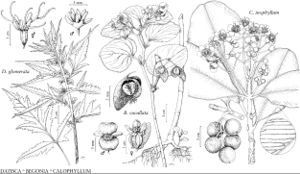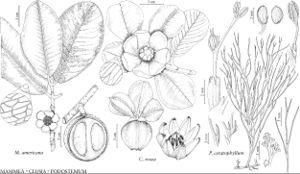FNA>Volume Importer |
FNA>Volume Importer |
Revision as of 22:42, 16 December 2019
Trees [shrubs], polygamous or dioecious, glabrous or hairy, hairs unicellular or multicellular, with glandular canals containing latex. Leaves opposite [alternate], decussate, simple, petiolate; blade: margins entire, surfaces with ± spherical glands containing secretions other than hypericin and pseudohypericin. Inflorescences axillary [terminal], pedicellate. Flowers bisexual or unisexual, homostylous; sepals persistent or deciduous, 2–4[–16], distinct or connate, inner pair often petaloid; petals deciduous, [0–]4–6[–8], decussate [contorted]; filaments basally connate [distinct], slender; anthers eglandular [glandular], dehiscing longitudinally; ovary superior, 1–8-locular; placentation basal; style 1; stigma ± expanded to peltate. Fruits baccate or drupaceous [capsular]. Seeds not arillate; embryo length 1/3+ times seed, cotyledons large.
Distribution
Fla., Mexico, West Indies, Central America, South America, Asia, Africa, Indian Ocean Islands (Madagascar), Pacific Islands, Australia, pantropical.
Discussion
Genera 14, species ca. 490 (2 genera, 2 species in the flora).
Selected References
Lower Taxa
Illustrations
Key
| 1 | Styles slender, lengths ca. 4 times ovary; sepals 4, distinct; leaves without tertiary venation visible between lateral veins. | Calophyllum |
| 1 | Styles thick, very short; sepals 2 or 3, completely connate in bud; leaves with tertiary venation prominent between lateral veins. | Mammea |

